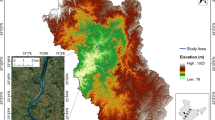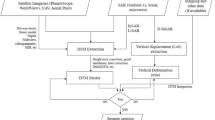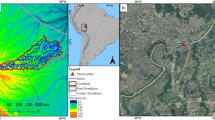Abstract
Watershed planning is a major issue in Turkey and other parts of the world. Surrounded by seawater on almost three-quarters of its international borders and by sheer mountains along the coastal regions and throughout the country, Turkey experiences a range of climatic changes, which constantly shape its topography. Recently, the occurrences of floods, landslides, and torrents have increased, forcing decision-makers to come up with solutions to manage and rehabilitate the upper watersheds in order to stop or limit the impact of disasters on downstream areas. Possible solutions should reduce flow coefficients, erosion, and sedimentation and increase reservoir capacities. It is expected that torrent volumes will decrease, drainage regimes on slopes will be better organized and adjusted, thawing snow will be better deposited and delayed, evapotranspiration will increase, surface runoffs will be delayed, and water regimes will be better managed, meaning that flood and torrent control will be achieved. For the reasons mentioned above, watershed parameters need to be firmly set. In the scope of this study, the elevation, slope acreage, and reservoir capacity of a small watershed, as extracted from open-access elevation models, were compared to a real-time kinematic (RTK) global positioning system (GPS)-generated point cloud and the resulting elevation model through various geospatial and analytical means. The Shuttle Radar Topography Mission (SRTM) C-band digital elevation model (DEM) (version 3) proved to be a satisfactory method in making residual, correlation, mean, and reservoir capacity comparisons. An L-band Advanced Land Observing Satellite (ALOS) phased-array-type synthetic aperture radar (PALSAR) and an X-band DLR_SRTM ASTER were slightly superior methods in terms of defining a greater number of slope categories than the other models. Finally, DLR_SRTM and SRTMv3 could match a greater number of slope façades than the other models. Seventeen years after its acquisition, SRTM and its derivatives have continued leading the topographic definition of the Earth.






Similar content being viewed by others
References
Aguilar, F. J., Agüera, F., Aguilar, M. A., & Carvajal, F. (2005). Effects of terrain morphology, sampling density, and interpolation methods on grid DEM accuracy. Photogrammetric Engineering and Remote Sensing, 71(7), 805–816.
Anornu, G. K., & Kortatsi, B. K. (2012). Comparability studies of high and low resolution digital elevation models for watershed delineation in the tropics: Case of Densu River basin of Ghana. International Journal of Cooperative Studies., 1(1), 9–14.
Aronof, S. (2005). Remote sensing for GIS managers. First. Redlands: ESRI Press 487 p.
Asmamaw, D. K. (2015). A critical review of integrated river basin management in the upper Blue Nile river basin: The case of Ethiopia. International Journal of River Basin Management, 13(4), 429–442.
Aster Global DEM Validation (2009). Summary report. 28 p. Available online at https://lpdaac.usgs.gov/sites/default/files/public/aster/docs/ASTER_GDEM_Validation_Summary_Report.pdf, last accessed 28 July 2017.
Benda, L., Miller, D., Barquin, J., McCleary, R., Cai, T. J., & Ji, Y. (2016). Building virtual watersheds: A global opportunity to strengthen resource management and conservation. Environmental Management, 57(3), 722–739.
Berthier, E., Schiefer, E., Clarke, G., Menounos, B., & Rémy, F. (2010). Contribution of Alaskan glaciers to sea-level rise derived from satellite imagery. Nature Geoscience, 3, 92–95.
Bhardwaj, A., Sam, L., Akanksha, F., Martín-Torres, J., & Kumar, R. (2016). UAVs as remote sensing platform in glaciology: Present applications and future prospects. Remote Sensing of Environment, 175, 196–204.
Bitelli, A. C. G., & Carla, R. (1997). Comparison of techniques for generating digital terrain models from contour lines. International Journal of Geographical Information Science, 11(5), 451–473.
Bolt, B. A., Horn, W. L., MacDonald, G. A. & Scott, R. F. (2013). Geological hazards: earthquakes - tsunamis - volcanoes - avalanches - landslides - floods. Revised, Second edition. Springer Science & Business Media. 332 p.
Boydak, M. & Caliskan, S. (2015). Afforestation in arid and semi-arid regions. 68 p. Available online at: http://www.cem.gov.tr/erozyon/Files/yayinlarimiz/AFFORESTATIONINARIDANDSEMIARIDREGIONS.pdf, last accessed 25 July 2018.
Ceylan, A., Alan, I. & Ugurlu, A. (2007). Causes and effects of flood hazards in Turkey. The proceedings of International Congress River Basin Management. Antalya, Turkey: 415–423.
Che, T., Li, X., Jin, R., & Huang, C. (2014). Assimilating passive microwave remote sensing data into a land surface model to improve the estimation of snow depth. Remote Sensing of Environment, 143, 54–63.
Deniz, R., Celik, R. N., Kutoglu, H., Ozludemir, M. T., Demir, C. & Kinik, I. (2008). Buyuk Olcekli Harita ve Harita Bilgileri Uretim Yonetmeligi. 86 p. Available online at: http://www.hkmo.org.tr/resimler/ekler/7VST_ff3e350028d0cfc_ek.pdf, last accessed 16 July 2018.
Duncan, J. M., Wright, S. G., & Brandon, T. L. (2014). Soil strength and slope stability (2nd ed.). John Wiley and Sons, Inc.: Hoboken 317 p.
Elkhrachy, I. (2016). Vertical accuracy assessment for SRTM and ASTER Digital Elevation Models: A case study of Najran city, Saudi Arabia. Ain Shams Engineering Journal, 2, 1–11.
EM-DAT (2009). Center for Research on the epidemiology of disasters. Available online at: http://www.emdat.be/database, last accessed 16 Mar 2017.
ESRI (2018). What is raster data?—Help | ArcGIS for desktop. Available online at: http://desktop.arcgis.com/en/arcmap/10.3/manage-data/raster-and-images/what-is-raster-data.htm, last accessed 16 July 2018.
FAO (2006). Guidelines for soil description. Fourth. Food and Agriculture Organization of the United Nations, Rome. 109 p. Available online at: http://www.fao.org/3/a-a0541e.pdf, last accessed 16 July 2018.
Gao, J. (1997). Resolution and accuracy of terrain representation by grid dems at a micro-scale. International Journal of Geographical Information Science, 11(2), 199–212.
Golding, B., Roberts, N., Leoncini, G., Mylne, K., & Swinbank, R. (2016). MOGREPS-UK convection-permitting ensemble products for surface water flood forecasting: Rationale and first results. Journal of Hydrometeorology, 17, 1383–1406.
Goulden, T., Hopkinson, C., Jamieson, R., & Sterling, S. (2016). Sensitivity of DEM, slope, aspect and watershed attributes to LiDAR measurement uncertainty. Remote Sensing of Environment, 179, 23–35.
Grohmann, C. H. (2015). Effects of spatial resolution on slope and aspect derivation for regional-scale analysis. Computational Geosciences, 77, 111–117.
Grohmann, C. H., & Sawakuchi, A. O. (2013). Influence of cell size on volume calculation using digital terrain models: A case of coastal dune fields. Geomorphology, 180-181, 130–136.
Grussenmeyer, P., Landes, T., Voegtle, T., & Ringle, K. (2008). Comparison methods of terrestrial laser scanning, photogrammetry and tachometry data for recording of cultural heritage buildings. The International Archives of the Photogrammetry, Remote Sensing and Spatial Information Sciences, XXXVI, 213–218.
Hilton, J. E., Miller, C., Sharples, J. J., & Sullivan, A. L. (2016). Curvature effects in the dynamic propagation of wildfires. International Journal of Wildland Fire, 25(12), 1238–1251.
Jenness, J. S. (2004). Calculating landscape surface area from digital elevation models. Wildlife Society Bulletin, 32(3), 829–839.
Jiang, S.-H., Li, D.-Q., Zhang, L.-M., & Zhou, C.-B. (2014). Slope reliability analysis considering spatially variable shear strength parameters using a non-intrusive stochastic finite element method. Engineering Geology, 168(86), 120–128.
Józsa, E., Fábián, S. Á., & Kovács, M. (2014). An evaluation of EU-DEM in comparison with ASTER GDEM, SRTM and contour-based DEMs over the Eastern Mecsek Mountains. Hungerian Geographic Bulletin., 63(4), 401–423.
Kang, M., Wang, M., & Du, Q. (2015). A method of DTM construction based on quadrangular irregular networks and related error analysis. PLoS One, 10(5), 1–17.
Kolecka, N., & Kozak, J. (2014). Assessment of the accuracy of SRTM C- and X-Band High Mountain Elevation Data: A case study of the Polish Tatra Mountains. Pure and Applied Geophysics, 171(6), 897–912.
Kweon, I. S., & Kanade, T. (1994). Extracting topographic terrain features from elevation maps. Cvgip:Image Underst., 59(2), 171–182.
López-Moreno, J. I., Revuelto, J., Gilaberte, M., Morán-Tejeda, E., Pons, M., Jover, E., Esteban, P., García, C., & Pomeroy, J. W. (2013). The effect of slope aspect on the response of snowpack to climate warming in the Pyrenees. Theoretical and Applied Climatology, 117(1), 207–219.
Mahmood, S., Khan, A. u. H., & Ullah, S. (2016). Assessment of 2010 flash flood causes and associated damages in Dir Valley, Khyber Pakhtunkhwa Pakistan. International Journal of Disaster Risk Reduction, 16, 215–223.
Mei, Y., Chang, C., Dong, Z., & Wei, L. (2016). Stream, Lake, and reservoir management. Water Environment Research, 87(10), 1515–1550.
Mispan, M. R., Zamir, M., Rasid, A., Faiza, N., Rahman, A., Haron, S. H., & Ahmad, N. (2015). Assessment of ASTER and SRTM derived digital elevation model for highland areas of peninsular Malaysia region. Concepts Journal of Applied Research., 02(09), 316–320.
Mukherjee, S., Joshi, P. K., Mukherjee, S., Ghosh, A., Garg, R. D., & Mukhopadhyay, A. (2013). Evaluation of vertical accuracy of open source digital elevation model (DEM). International Journal of Applied Earth Observation and Geoinformation., 21, 205–217.
Mukundan, R., Pradhanang, S. M., Schneiderman, E. M., Pierson, D. C., Anandhi, A., Zion, M. S., Matonse, A. H., Lounsbury, D. G., & Steenhuis, T. S. (2013). Suspended sediment source areas and future climate impact on soil erosion and sediment yield in a New York City water supply watershed, USA. Geomorphology., 183, 110–119.
Munir, B. A., & Iqbal, J. (2016). Flash flood water management practices in Dera Ghazi Khan City (Pakistan): A remote sensing and GIS prospective. Natural Hazards, 81(2), 1303–1321.
Nichol, J. E., Shaker, A., & Wong, M. S. (2006). Application of high-resolution stereo satellite images to detailed landslide hazard assessment. Geomorphology, 76(1–2), 68–75.
Patel, A., Katiyar, S. K., & Prasad, V. (2016). Performances evaluation of different open source DEM using differential global positioning system (DGPS). The Egyptian Journal of Remote Sensing and Space Sciences, 19(1), 7–16.
Pradhan, B. & Abdulwahid, W. M. (2017). Landslide risk assessment using multi-hazard scenario produced by logistic regression and LiDAR-based DEM in Laser Scanning Applications in Landslide Assessment: 253–275.
Risbøl, O., Briese, C., Doneus, M., & Nesbakken, A. (2015). Monitoring cultural heritage by comparing DEMs derived from historical aerial photographs and airborne laser scanning. Journal of Cultural Heritage, 16(2), 202–209.
Rufino, G., Moccia, A., & Esposito, S. (1998). DEM generation by means of ERS tandem data. IEEE Transactions on Geoscience and Remote Sensing., 36(6), 1905–1912.
Shin, H., Kim, Y. T., & Park, D. K. (2013). Development of rainfall hazard envelope for unsaturated infinite slope. KSCE Journal of Civil Engineering, 17(2), 351–356.
Sturm, T., & Podobnikar, T. (2017). A probability model for long term forest fire occurrence in the karst forest management area of Slovenia. International Journal of Wildland Fire., 26, 399–412.
Sullivan, A. L., Sharples, J. J., Matthews, S., & Plucinski, M. P. (2014). A downslope fire spread correction factor based on landscape-scale fire behaviour. Environmental Modelling and Software., 62, 153–163.
Surazakov, A. B., & Aizen, V. B. (2006). Estimating volume change of mountain glaciers using SRTM and map-based topographic data. IEEE Transactions on Geoscience and Remote Sensing, 44(10), 2991–2995.
Tayanc, M., Im, U., Dogruel, M., & Karaca, M. (2009). Climate change in Turkey for the last half century. Climatic Change, 94(3–4), 483–502.
Turker, A. & Acikgoz, T. (2006). Orman Isletmelerinin Etkinliklerine Iliskin Finansal Cozumlemeler in the Proceedings of “Ormancilikta Sosyo Ekonomik Sorunlar Kongresi” _2006. Cankiri: 163–173. Available online at: http://www.foresteconomics.org/congress/proceedings_2006.pdf, last accessed 25 July 2018.
Turner, K. G., Anderson, S., Gonzalez, M., Costanza, R., Courville, S., Dominati, E. & Ogilvy, S. (2014). Toward an integrated ecology and economics of land degradation and restoration: Methods, data, and models. Report to the ELD Project Data and Methodology Working Group: 1–60.
Uysal, M., Toprak, A. S., & Polat, N. (2015). DEM generation with UAV photogrammetry and accuracy analysis in Sahitler hill. Measurement, 73, 539–543.
Yang, R., Chang, Z. & Xue, T. (2011). 3D terrain visualization for Mountain Taishan. ICSDM 2011 - Proc. 2011 IEEE Int. Conf. Spat. Data Min. Geogr. Knowl. Serv:285–290. Available online at: https://ieeexplore.ieee.org/stamp/stamp.jsp?tp=&arnumber=5969048, last accessed 25 July 2018.
Yang, P., Ames, D. P., Fonseca, A., Anderson, D., Shrestha, R., Glenn, N. F., & Cao, Y. (2014). What is the effect of LiDAR-derived DEM resolution on large-scale watershed model results? Environmental Modelling and Software, 58, 48–57.
Zhou, J., Li, Z., & Xing, Q. (2011). Monitoring thickness changes of mountain glacier by differential interferometry of ALOS PALSAR data. IEEE International Geoscience and Remote Sensing Symposium, 24-29 July 2011, Vancouver, BC, CANADA, 3649–3652.
Ziadat, F. M., & Taimeh, A. Y. (2013). Effect of rainfall intensity, slope, land use and antecedent soil moisture on soil erosion in an arid environment. Land Degradation and Development, 24(6), 582–590.
Author information
Authors and Affiliations
Corresponding author
Rights and permissions
About this article
Cite this article
Altunel, A.O. Suitability of open-access elevation models for micro-scale watershed planning. Environ Monit Assess 190, 512 (2018). https://doi.org/10.1007/s10661-018-6890-1
Received:
Accepted:
Published:
DOI: https://doi.org/10.1007/s10661-018-6890-1




